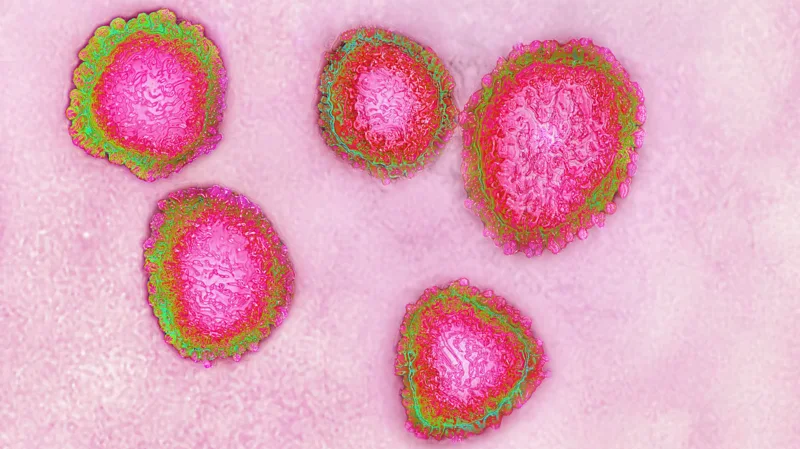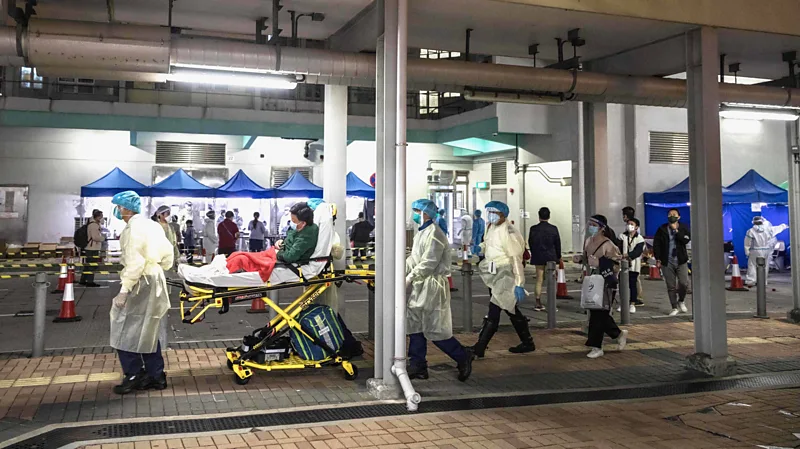Covid-19 has its footprints on almost every doorstep of the world; however, the case of hospitalization is looking better than the rest. The reason is still unknown.
In the eyes of ardent virologists, the fears began to build when they got the first glimpse of XEC, the COVID variant that began gaining traction in late 2024.
XEC is supposed to be the final chronological of the Omicron strain and is believed to be developed by Recombination as a process of amalgamating genetic materials of two distinct variants. Recent studies suggest that XEC can bypass the shield provided by recovering from the older jn1 or kp2 version and the latest vaccines that are still in circulation.
As per Kei Sato, a renowned TVo professor, the exec variable made a lot of sense due to its massive difference in spike structure from older versions. His initial Junio14 study put forward in 202 تكون published in December 2024, shed light on JN1-based immunity’s inducing limitations.
Out of concern, the Thanksgiving holiday weekend, Infectious disease experts expected a swift increase in hospital admissions over. However, they were not correct. In major cities, monitoring expenditures gave a clear indication of a surge in COVID-19 patients. Even then, however, the winter surge in admissions did not amount to significantly higher numbers than the comparisons between people who ended up in the hospital during the northern hemisphere winter seasons. Data collected by the CDC indicates that the 6.1 admissions per 100,000 people in the first week of December 2023 was a considerable rise; however, in the same week of December 2024, it sunk to two out of every 100,000 people.

What was taking place?
Peter Chin-Hong, a professor in the Health Division of Infectious Diseases at the University of California, San Francisco, stated, “There is a vast amount of COVID in the sewage, but we are currently witnessing extremely low levels of critically ill people.” It goes on to demonstrate that regardless of how terrifying a variant may appear in the laboratory, the conditions under which it is released are always more hostile, which is always the case.
A few clues point to the fact that COVID-19 is a relatively mild disease in 2025; the patients’ earlier prevalent complaints of a loss of smell and taste have become less common nowadays. Contrary to what many would think, there are still some people being admitted to hospitals and some even dying; Chin-hong insists that most people would not suffer symptoms — only the sniffles of an upper-respiratory infection or the mild feelings of having a pollen allergy or even none at all. This group of patients may include those with weak immune systems. However, he maintains that the transformation of COVID-19, while posing a major threat, continues to be the age aspect, and currently, owing to old age, COVID-19 poses the biggest threat to those who are more than 75 years old.
Even so, the specialists have recommended that all high-risk individuals get the new COVID-19 vaccine, which could prevent them from getting severely ill, being hospitalized, or dying. Moreover, although XEC is associated with less severe disease, it does not rule out the possibility that other more severe variants might come out in the future. This suggests that the battle against Covid-19 is over and should never be taken lightly. They continue to regard it as a topical and permanent danger to people’s health. The threat of Long Covid remains. And for some of them it can last for years.
Microbiology associate professor Harm Van Backel explains that the Covid case load is negligible in comparison to XEC’s introduction this winter, which is said to not surpass Van Backel’s expectations. Backel is the co-leader of the Mount Sinai Pathogen Surveillance Program located at the Icahn School of Medicine within the Mount Sinai Health System. He can expect that around 10% of cases will be from the SARS-CoV-2 virus once the winter season has fully begun; in other words, there has been a considerable decline in cases during the past winter season. Backel has also predicted that COVID would contribute to the remaining caseload, but the amount would be within reason, “In comparison with other respiratory viruses, myself included, would say that it has been relatively quiet for the past 6 months.”
While still used in dire cases, Chin-Hong recalls that dexamethasone has been retired from regularly being prescribed as, over time, the risks of clotting have dropped, along with most medicines; this seems to be the new normal, though. He also mentions that methods and procedures in hospitals have shifted drastically in recent years as well; for example, the most commonly used treatment, antivirals, have replaced steroids.
According to Chin-Hong, Omicron is now more capable of causing coughs and colds instead of pneumonia, as well as causing cardiovascular or clotting diseases. He emphasizes that a patient’s time in the hospital is achieving an all-time minimum.

What has changed?
Marc Johnson is a molecular virologist working at the University of Missouri School of Medicine. It is one of his duties to monitor various respiratory viruses. He, too, has cases in which he must determine how extensive the COVID-19 virus is currently. While Chin-Hong is still quite popular, he has extensive experience with the virus.
“As we began our air sampling around various sites near the university, it was remarkable how we gathered a sample surrounding students while not detecting Covid,” he explains. “With how often we still get exposed to Covid, it’s likely most infections are just being blunt.”
However, that still does not address the other important questions, specifically how. Sato points out that the context behind COVID variants appearing scarier than usual is due to their virulence being measured by injection into hamsters and explains, “Hamsters have not been vaccinated. Hamsters are very similar to the humans of 2019; they have no specific anti-SARS-CoV-2 immunity. The situation is drastically different with humans of 2025”.
In contrast, our evaluation of the ability to blunt the new types of Covid was not significantly conducted by the level of formed antibodies.
Global immunization coverage is decreasing rapidly; according to CDC data, only 21.5 % of adults and 10.6% of children in the United States had been administered the 2024-2025 Covid vaccine by the end of January, while Sato and his colleagues observed that the XEC variant was able to outcompete neutralizing antibodies that developed after infection with prior Omicron subvariants.
According to Chin-Hong, there are two scenarios. The first is that the great majority of individuals have now become both vaccinated and infected so many times that they have a very strong immune memory of the appearance of the virus around them and therefore, any new infection is quickly wiped out before it can go very deep into the body. He is of the opinion that the continuing downward trend in new long Covid cases could be further evidence of this.
“Even if Covid gets in, right now it’s going to be identified and kicked out of the body pretty efficiently,” says Chin-Hong. “More often than not, it is unable to remain long enough to inflict significant illness or long-term complications. With long Covid, one Theorist suggests that the virus is one of the factors behind this abnormal immune response, but if it is unable to take tissues for a longer time, then there is a lesser problem for that to happen,” he says.
The other die is whether Covid has now entered a cold season, which means it will continue to be more and more and more while being infectious until it is finally comparable to a cold. Chin-Hong again adds that this would not be surprising, especially when we consider the previous outbreaks of coronaviruses.
It seems that COVID-19 will linger on for quite some time as Chin-Hong commented that “coronary viruses may be fundamentally different from influenza viruses,” implying that the risk from COVID-19 could be significantly lower over time as population immunity increases. Such statements also further lead him to speculate the possibility of long-term COVID-19 being potentially less prevailing as well: “In terms of its evolution, the virus constantly forms new variants creating terrifying appearances in the laboratory but on the other hand as the population immunity grows we might experiencing less invasive illnesses.”
It’s impossible to say the direction COVID-19’s evolution will take
While a belief has been formed centered around Omicron being the final covid super variant, Which seemingly spun off from Alpha, Delta, as well as the November 2021 variant, albeit minuscule, there haven’t been significant curve-shifting variants released in the past 3 years, leading to the conclusion that their initiated direction was the final one.
Johnson takes a different angle, though: he concedes the possibility of a new mutation emerging that works off the foundations of the delta variation of the previous decade, but in that case, there are preconditions: The individual in context has to be immunocompromised to considering amplify the alter ego, “the result will be the body registering the new virus as unfamiliar and thus the body sick and lead to greater hospitalizations.”
“Although it is not prevalent now, we do sometimes find strains from about two to three years ago,” Johnson observes. “The situation also changes if one of those older strains becomes more widespread since people already have a Delta infection. All these factors combined would baffle people’s immunity – it would all look so different to the past three years.”
Johnson adds, however, that the distortions could be even more remarkable. He explains that some signals suggest that the new trajectory of COVID-19 could ultimately turn it into a fecal-oral virus rather more comparable to norovirus, cholera or hepatitis A than the cold.
On social media, X, Johnson calls himself a “wastewater detective” and further comments on how some of the most accurate predictions can be made by following the traces of Covid in the sewer. According to Johnson, SARS-CoV-2 can also be found in the gut of those infected for an extended period, and along with Johnson, some of his other colleagues have been able to identify certain people who have a long-term bowel infection. Such patterns were not observed in clinical samples, say, in patients of hospitals, but rather in sewage systems, and they were formed not by the COVID virus but by the gut vesicular viruses. The colonization strain belonged to complete cryptic lineages, which covered only sewage. This means that all the excess of one of the types of these viruses has up to six anonymous individuals, and these confusing types strive to be excreted.

Johnson predicts that this sort of thing takes place from time to time because a type of COVID has been changed and, therefore, developed to be an infection for the bowels for a long time. For this reason, he has reason to think that SARS-CoV-2 may eventually mutate to be transmitted in stool particles similar to the other fecal-oral viruses.
“A lot of the bat coronaviruses, that’s how they spread,” says Johnson. “Interestingly, the evolutionary ancestors of Covid were not respiratory viruses; they were enteric viruses [those that live in the gut], spread via water, food or contact with people. So Covid may become a completely food-borne pathogen, but no, that is not going to happen during our lifetime.”
The other key question is what having COVID-19 for a longer period as a gastrointestinal infection effect could be and how frequent this one is, too. For that reason, he is currently trying to find subjects who suffered from COVID-19 and have had any chronic gastrointestinal symptoms after the infection for a sample study.
Johnson contends that it’s essential for the public’s well-being to delve into the ramifications of long-term gut infections caused by COVID-19. When looking into wastewater, he’s been able to identify a recurring region that would often vanish after a long period while refusing to disclose why he believes it occurs or what it means. Probably, the person dies. “This is why there’s a ton of unanswered questions,” he continues.
In that context, meanwhile, the majority of COVID-19-infected patients are asymptomatic, but researchers such as Johnson or Chin-Hong stress the importance of getting vaccinated and the importance of pharmaceutical companies to develop next-generation vaccines. Lee points out that the new phase of the COVID-19 vaccination effort is good-natured because Chin-Hong notes that the new mucosal vaccines are supposed to prevent forward spread rather than just preventing severe infection and disease. In addition, work continues on a universal COVID-19 vaccine, which does not have to be updated every year.
“The next step regarding Covid remains truly ambiguous, and that’s what Chin-Hong said. He added, “Although the chances of serious sickness and hospitalization have decreased, advanced medication as well as better vaccines for some individuals, at least in the future, are still a must.”
